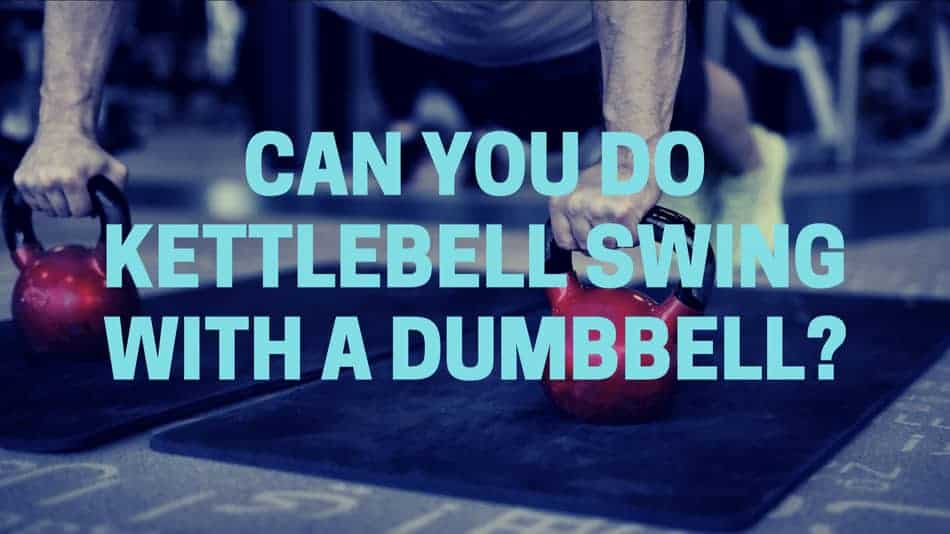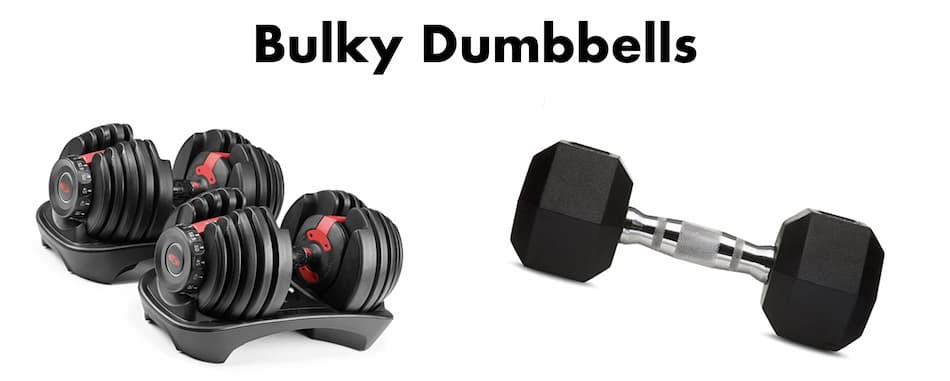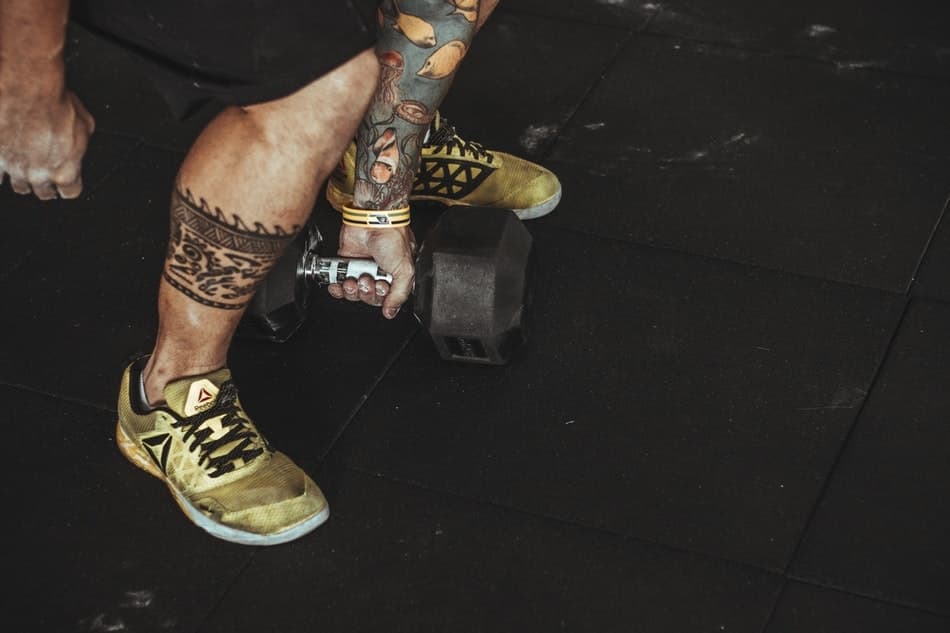Having access to a complete set of kettlebells is perfect because you can use them for exercises like swings, lunges, squats, and more. However, what happens if you don’t have a kettlebell and you want to do swings?
Today I will explain if it’s worth (or not) doing kettlebell swings with a dumbbell, especially, when you don’t have kettlebells at hand.

Overall, you can do kettlebell swings with a dumbbell, however, to perform this exercise correctly, you must hold the weight, not by the handle, but by the plate. The position of the dumbbell must be vertical. To get better support and grip, use gloves or chalk.
Here is my quick answer but if you wanna know more details about how to do KB swings with a dumbbell and (most importantly) which dumbbells are the most suitable, keep reading.
Dumbbell swings vs kettlebell swings
In general, dumbbell swings aren’t as good as kettlebell swings becasue it’s less comfortable to hold the dumbbells by the plate, which limits your range of motion and restricts the amount of weight you can use.
However, it can be done. If you want to do kettlebell swings with a dumbbell you must be a little bit creative.
I personally don’t do many kettlebell exercises if I don’t have access to kettlebells.
For me, it feels limited.
- I cannot use the same dumbbell weight as I would with the kettlebell.
- I have a difficult time grabbing the dumbbell and swinging for a long period of time.
Plus, many dumbbells have weird shapes and are just not suitable for doing hip hinge movements.
However, when I was training my clients, and the gym was packed and we had nothing else available, we used to do all sorts of weird stuff. Including swings with a dumbbell.
Dumbbell swings are a great alternative when nothing else is available
One reason why you may need to use dumbbells for kettlebell swings is that the gym may not have enough kettlebells available.
Plus, during busy times like January and February, most of the equipment is used, especially at peak times (between 5 pm to 8 pm).
In other words, if you don’t have what you like, you must like what you have. Let me show you how.
How can you use a dumbbell for kettlebell swings?
Here are the steps.
Step 1
- Keep your feet shoulder-width apart.
- There should be enough space between your legs to allow for the dumbbell swing. Ideally, you want your dumbbell to be placed in line with your feet.
- If you place the dumbbell too far behind, or too far forward, this will cause your back to bend and can lead to further issues.
Step 2
- Place the dumbbell to stand vertically, between your feet.
- This means, that one plate will be on the ground, and the opposite plate is facing up, towards you.
- Next, grab a dumbbell, with both hands by the plate.
- Keep your hands laterally (outside) of the plate. This hand position will allow your shoulders to be in a nice, externally rotated position.
Step 3
- With a kettlebell swing, you are doing a hip hinge movement.
- This means all the movement is in your hip joint, not in your lower back. You must bend your hips, stay soft on your knees, and keep your back straight.
Step 4
- To make a swing, thrust from your hips and swing the dumbbell up towards the ceiling.
- Do not “lift” the weight.
- Think about how the pendulum works, or the swing in the park. As you swing the dumbbell up, you should stop at shoulder level.
Step 5
- Once you swing your dumbbell, drive it up towards the shoulder level.
- No need to go above your shoulder line.
- Sometimes you will see people swing where they drive the kettlebell over their head. That’s not necessary. It doesn’t bring you better results, but it is bad for your shoulders.
- You may get away with swinging your kettlebell over your shoulder, but don’t try that with the dumbbell.
- When the kettlebell travels towards your shoulder level, lock your hips by squeezing your butt. Here your torso should be straight, and your knees should be straight too.
Step 6
- The last step is to let the dumbbell “swing back” to the starting position.
- You want to have control over the weight, but do not “carry” the weight down. It should just swing back naturally.
How to do kettlebell swings with dumbbells (video)
Below you can find one of the best video tutorials on how to do kettlebell swings with a dumbbell (and how not to do it) from the YouTube channel Strong Made Simple.
Safety
In general, doing kettlebell swings with a dumbbell is safe, as long as you’re using the appropriate weight and performing the exercise with the correct form.
The difference between a kettlebell swing and a dumbbell swing is in the grip.
- The kettlebell is designed in a way that you can hold it comfortably. It is basically an asymmetric, iron, or metal cast, with one handle attached.
- The handle usually stays pointed up towards the ceiling, and the weight is at the bottom. And as long as you hold the kettlebell by the handle, you are safe. But what about the dumbbell?
The dumbbell is different.
- The dumbbell is symmetric because you have two equal-weight plates attached to the handle in the middle. This way the weight is evenly redistributed as you lift.
- However, when performing the dumbbell swing, the weight becomes more difficult to hold, therefore you have less control over the swing movement.
How to choose dumbbells for kettlebell swings?
There are many different types and brands of dumbbells. Some work perfectly fine for doing swings, however, others just aren’t right for it.
The difference is usually in the plate size, plate shape, weight, or material that’s been used to coat the dumbbell.
- The best dumbbells suitable for kettlebell swings have flat plates, can stand alone vertically, and are easy to grab.
- The worst dumbbells for swings have bulky plates that are uneven and hard to hold.
Shape
- Do be able to do kettlebell swings with the dumbbells, the shape of the plate needs to be as thin as possible. This way it will ensure the proper grip.
- Dumbbells that have bulky plates are great to do push-ups or renegade row push-ups, but they are horrible to do swings.
- Simply because the grip is too thick and you cannot hold the weight comfortably.
In the pictures below you have two examples of bulky dumbbells (the picture on the left is a dumbbell set from Bowflex, whereas the picture on the right is a rubber hex dumbbell).

Weight
Another factor is the weight of the dumbbell.
- The heavier dumbbell usually requires more plates to be stuck on both sides.
- This makes it very difficult to hold on to. With kettlebells, you can swing even the heavyweight, because it’s got a suitable handle.
Quality
Always think about your safety first.
- The last thing you want is for your dumbbell falls apart during your heavy dumbbell swings.
- If you see that screws are missing, or the robber isn’t in the best shape, or some parts are sticking out, or the plates aren’t stable, then I wouldn’t use that for swings.
Best dumbbells for kettlebell swings
In general, the best dumbbells for kettlebell swings are from a company called Relife. These weights have a decagonal appearance design, which makes them easier to hold. They are covered with a PEV polymer material that can resist any impact, and corrosion and have a long shelf-life.
- You want to make sure your dumbbell has a nice, handy shape.
- Ideally, the material will be made from some high-quality, non-slippery rubber.
- The plates should be thin but heavy enough to feel the training benefits.
- Also, the plates won’t take up much space. You don’t want to have 4-5 layers or plates stuck up on each other.
Other kettlebell exercises that you can do with a dumbbell
Here’s the good news. You already know how to perform a kettlebell swing using a dumbbell correctly.
And you know what the best types of dumbbells for this job are.
Here’s the better news.
There are several more kettlebell exercises that you can do using the dumbbell.
Single Arm Snatch

- Single arm snatch is a great, explosive movement that works on your power, and strength.
- It requires you to grab the dumbbell by the handle, and snatch it up the ceiling over your head.
- When you do this exercise, you want to keep the dumbbell as close to your body as possible.
Single Arm Overhead Press

- This exercise is usually called shoulder press, military press, or just overhead press.
- Normally, shoulder press you do with both hands at the same time.
- It requires you to lift the weight over your head. Here, you still can do it, even with just one hand at a time.
- All you need is to stand straight, keep your core engaged, and press.
Goblet Squat

- Goblet squat you can do with either kettlebell or dumbbell.
- You hold the weight similarly like to the swing, but you place your arms under the plate.
- Make sure you have the weight touching your chest.
- Standing with shoulder-width apart, lower yourself down, until your elbows touch your knees, and then come back up.
Conclusion
- You can do kettlebell swings with a dumbbell, however, it won’t feel as much comfortable as with the KB.
- You should do KB swings with a dumbbell by holding the plate, not the handle. Holding the dumbbell by the handle can result in poor form and incorrect biomechanics.
- For safety reasons, I wouldn’t recommend using bulky and broken dumbbells.
